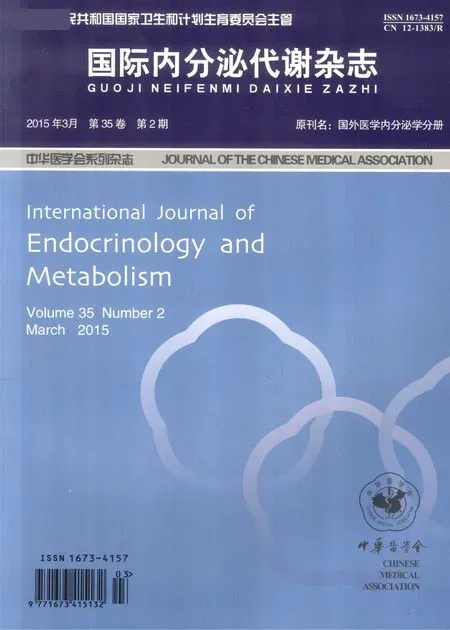P2X7受体与糖尿病视网膜病变
2015-03-20刘琦周赛君孟振兴于珮
刘琦 周赛君 孟振兴 于珮
P2X7受体与糖尿病视网膜病变
刘琦 周赛君 孟振兴 于珮
P2X7受体是一种重要的凋亡调控受体,是嘌呤受体家族中的一员,也是ATP活化的配体门控离子通道的调节者。它在中枢和外周神经系统中对介导兴奋性神经递质起重要作用。P2X7受体广泛表达于视网膜多种细胞表面。研究显示,P2X7受体在糖尿病视网膜病变中过度激活,参与糖尿病视网膜病变的发生及发展。一方面,P2X7受体过度激活所致的嘌呤血管毒性,可导致视网膜血流减少和血管功能的紊乱;另一方面,P2X7受体活化可导致大量炎性因子的产生,引起局部炎性细胞浸润,形成血管炎性微环境,构成糖尿病视网膜病变发生、发展的病理生理基础。
P2X7受体;糖尿病视网膜病变;细胞凋亡;炎症
糖尿病视网膜病变(DR)的主要特征是微血管周细胞和内皮细胞凋亡。周细胞和收缩细胞位于毛细血管腔壁,其损伤可导致微血管瘤和新生血管的形成。内皮细胞损伤可以导致血-视网膜屏障的破坏和黄斑水肿。目前关于DR中周细胞和内皮细胞凋亡的机制,包括氧化应激、晚期糖基化终末产物、蛋白激酶C上调激活多元醇通路和局灶性白细胞黏附等,但具体机制尚不完全明了[1-4]。
P2X7受体激活不仅能导致非选择性膜通道的开放,且随着活化的持续,在多种类型的细胞膜上形成跨膜孔,相对分子质量小于900的亲水性分子能自由通过,引起细胞钙内流增加和膜电位降低,而后者又可激活电压门控钙通道,进一步促进钙内流[5]。一方面,钙内流可引起周细胞收缩,加重毛细血管及组织缺氧;另一方面,钙内流导致细胞钙超载,加速细胞凋亡[6]。P2X7受体的异常表达或激活与多种疾病有密切关系,如帕金森综合征、阿尔茨海默病和多发性硬化症等[7-8]。已发现在缺血性脑皮层中,该受体异常表达能高度上调神经元和神经胶质细胞的功能。
1 视网膜中的P2X7受体
P2X7受体可在视网膜大多数类型的细胞中表达,包括神经元(如神经节细胞、神经胶质)和血管细胞[8]。视网膜微血管网中P2X7受体的活化通过增加细胞外钙的水平介导周细胞收缩并通过微血管网内细胞间电传输动态调节血管舒缩反应。使用新分离的大鼠视网膜微血管,通过穿孔膜片钳检测离子电流,通过fura-2测得细胞内钙水平,借助可视化微血管收缩与延时摄影技术,发现ATP诱发离子电流去极化,增加细部内钙水平并引起周细胞收缩。多项实验均表明P2Y4受体介导的储存钙的释放以及通过活化的P2X7受体/通道大量钙涌入是ATP诱导的细胞内钙升高的主要原因[9-10]。
P2X7的异常激活通过依赖于细胞内Ca2+增加的方式,导致视网膜神经节细胞死亡[11]。另一研究表明,上调P2X7受体可引起视网膜神经元的损伤,从而导致视网膜损伤[12]。有研究证实,P2X7受体的活化参与了缺氧诱导的视网膜神经元的凋亡[13]。
Liao和Puro[14],对分离得到的糖尿病大鼠微血管的研究表明,最大有效剂量P2X7嘌呤受体激动剂苯甲酰基苯甲酰基-ATP(BzATP,2 nmol/L)即可引起微血管毛孔形成。NAD+可触发视网膜微血管发生P2X7依赖性细胞死亡。同样,视网膜微血管对细胞外NAD+的血管毒性作用的敏感性也增加100倍。使用激光散斑循环分析仪和视网膜电图描记术进行体内研究发现,糖尿病兔模型玻璃体内注射50 nmol BzATP后,视网膜血流速度降低近30%,视网膜功能更加脆弱[15]。其他研究也证实,生理环境下,P2X7通过硝酸氧化物和P2Y4受体依赖性途径的调节在细胞膜上形成孔,如果硝酸氧化物和P2Y4受体依赖性途径调节紊乱,嘌呤的血管毒性作用可加速微血管细胞的死亡,这是DR形成和发展的标志[16]。
2 P2X7受体所致的嘌呤毒性作用与DR
P2X7受体活化可显著增加视网膜微血管的脆性,被称为嘌呤的血管毒性[16]。如何能使潜在的嘌呤受体不发挥其被激活后引起的视网膜微血管细胞死亡的作用?因此产生出一个假定的构想,即可能存在阻止血管活性信号ATP触发嘌呤血管毒性的另一个调节机制。
研究发现,即使让分离的视网膜微血管暴露于ATP或BzATP,也不能引起细胞膜孔的形成和微血管细胞死亡[14]。ATP伴随G蛋白耦联受体P2Y4同时活化,阻止了P2X7嘌呤受体的活化,引起跨膜孔的形成和细胞死亡。P2Y4介导的保护作用依赖于储存钙的释放和同型磷脂酶A2的活化[17]。尽管与P2X7嘌呤受体/通道活化有关的事件以及跨膜孔开放的保护机制还有待阐明,但是已明确激活P2X7受体的同时伴随另一个P2X家族成员——P2Y4受体的活化。
在体内,另有其他机制也参与了嘌呤血管毒性对糖尿病视网膜微血管的调节。NAD+是视网膜中的一个细胞外信号分子,把成熟T细胞暴露于NAD+,可诱导细胞死亡。ART2(T细胞表达的一种毒素相关的ADP核糖基化胞外酶)可催化ADP-核糖基化,激活细胞毒性P2X7嘌呤受体,从而导致跨膜孔的形成和细胞死亡[18]。另有研究表明,通过依赖外生核糖基化的机制,细胞外NAD+可引起P2X7嘌呤受体的活化,从而导致大量跨膜孔的形成和微血管细胞的死亡。因此,由于P2X7受体的选择性活化,NAD+是触发视网膜微血管嘌呤血管毒性的另一个候选分子[19]。
3 P2X7受体所致的炎性反应与DR
研究表明,P2X7受体能促进促炎细胞因子的释放。P2X7受体可以通过调节白细胞介素-1β的加工和释放,影响神经元细胞死亡。神经性疼痛和慢性炎性疼痛动物模型中,P2X7受体基因敲除后,炎性反应明显减弱[20]。而最近对DR实验模型的研究表明,P2X7受体可调节细胞因子诱导的炎性反应,降低血-视网膜屏障的完整性,加重视网膜血管的闭塞和缺血[21]。研究发现,P2X7受体激动剂可增加低氧诱导的视网膜小胶质细胞释放白细胞介素-1β和肿瘤坏死因子-α。亦证实,眼内压升高后伴随P2X7受体活化增加,导致肿瘤坏死因子-α,、白细胞介素-1β、-6上调,参与了视网膜神经节细胞的死亡[8]。目前的发现进一步证明了P2X受体,尤其是P2X7受体是参与炎性反应的重要免疫调节受体[22]。
因此,P2X7受体在DR中过度激活,参与DR的发生与进展:一方面P2X7受体的过量活化所致的嘌呤血管毒性可导致视网膜血流的减少和血管功能的紊乱;另一方面P2X7受体的活化可导致大量炎性因子的产生。P2X7嘌呤受体将是DR一个潜在的治疗靶点,通过抑制该受体表达和(或)激活,可减少或阻止视网膜细胞的死亡,改善视网膜血流和发挥抗炎作用,对DR的防治具有重要意义。
[1]Tarallo S,Beltramo E,Berrone E,et al.Human pericyte-endothelial cell interactions in co-culture models mimicking the diabetic retinal microvascular environment[J].Acta Diabetol,2012,49(Suppl 1):S141-S151.
[2]Enge M,Bjarnegård M,Gerhardt H,et al.Endothelium-specific platelet-derived growth factor-B ablation mimics diabetic retinopathy[J].EMBO J,2002,21(16):4307-4316.
[3]DeVriese AS,Verbeuren TJ,Van de Voorde J,et al.Endothelial dysfunction in diabetes[J].Br J Pharmacol,2000,130(5):963-974.
[4]Talahalli R,Zarini S,Tang J,et al.Leukocytes regulate retinal capillary degeneration in the diabetic mouse via generation of leukotrienes[J].J Leukoc Biol,2013,93(1):135-143.
[5]Notomi S,Hisatomi T,Kanemaru T,et al.Critical involvement of extracellular ATP acting on P2RX7purinergic receptors in photoreceptor cell death[J].Am J Pathol,2011,179(6):2798-2809.
[6]Fukumoto M,Nakaizumi A,Zhang T,et al.Vulnerability of the retinal microvasculature to oxidative stress:ion channel-dependent mechanisms[J].Am J Physiol Cell Physiol,2012,302(9):C1413-C1420.
[7]Romagnoli R,Baraldi PG,Cruz-Lopez O,et al.The P2X7receptor as a therapeutic target[J].Expert Opin Ther Targets,2008,12(5):647-661.
[8]Sugiyama T,Lee SY,Horie T,et al.P2X7receptor activation may be involved in neuronal loss in the retinal ganglion cell layer after acute elevation of intraocular pressure in rats[J].Mol Vis,2013,19:2080-2091.
[9]Kawamura H,Sugiyama T,Wu DM,et al.ATP:a vasoactive signal in the pericyte-containing microvasculature of the rat retina[J].J Physiol,2003,551(15):787-799.
[10]Wurm A,Pannicke T,Iandiev I,et al.Purinergic signaling involved in Müller cell function in the mammalian retina[J].Prog Retin Eye Res,2011,30(5):324-342.
[11]Hu H,Lu W,Zhang M,et al.Stimulation of the P2X7receptor kills rat retinal ganglion cells in vivo[J].Exp Eye Res,2010,91(3):425-432.
[12]Franke H,Klimke K,Brinckmann U,et al.P2X (7)receptormRNA and protein in the mouse retina;changes during retinal degeneration in BALBCrds mice[J].Neurochem Int,2005,47(4):235-242.
[13]Sugiyama T,Oku H,Shibata M,et al.Involvement of P2X7receptors in the hypoxia-induced death of rat retinal neurons[J].Invest Ophthalmol Vis Sci,2010,51(6):3236-3243.
[14]Liao SD,Puro DG.NAD+-induced vasotoxicity in the pericytecontaining microvasculature of the rat retina:effect of diabetes[J].Invest Ophthalmol Vis Sci,2006,47(11):5032-5038.
[15]Sugiyama T,Oku H,Komori A,et al.Effect of P2X7receptor activation on the retinal blood velocity of diabetic rabbits[J].Arch Ophthalmol,2006,124(8):1143-1149.
[16]Suguyama T.Role of P2X7receptors in the development of diabetic retinopathy[J].World J Diabetes,2014,5(2):141-145.
[17]Sugiyama T,Kawamura H,Yamanishi S,et al.Regulation of P2X7-induced pore formation and cell death in pericyte-containing retinal microvessels[J].Am J Physiol Cell Physiol,2005,288(3):C568-C576.
[18]Seman M,Adriouch S,Scheuplein F,et al.NAD-induced T cell death:ADP-ribosylation of cell surface proteinsby ART2 activates the cytolytic P2X7purinoceptor[J].Immunity,2003,19(4):571-582.
[19]Puro DG.Retinovascular physiology and pathophysiology:new experimental approach/new insights[J].Prog Retin Eye Res,2012,31(3):258-270.
[20]Stephen DS,Debetto P,Giusti P,et al.The P2X7purinergic receptor:from physiology to neurological disorders[J].FASEB J,2010,24(2):337-345.
[21]Liou GI.Diabetic retinopathy:role of inflammation and potential therapies for anti-inflammation[J].World J Diabetes,2010,1(1):12-18.
[22]Di Virgilio F.P2X Receptors and inflammation[J].Curr Med Chem,2015,22(7):866-877.
P2X7receptor and diabetic retinopathy
Liu Qi,Zhou Saijun,Meng Zhenxing,Yu Pei.The Key Laboratory of Hormones and Development(Ministry of Health),Department of Kidney Dialysis,The Metabolic Diseases Hospital,Tianjin Medical University,Tianjin 300070,China
Yu Pei,Email:yupei@tijmu.edu.cn
P2X7receptor,an important apoptosis regulatoryreceptor,is a member ofthe purinergic receptor family and a regulator ofthe ligand gated ion channel activated by ATP.P2X7plays an important role in meditatingexcitatoryneurotransmitter in the central and peripheral nervous system.The expression ofP2X7receptor has been demonstrated in most types of cells in the retina.Studies have shown that excessive activation of P2X7receptor involves in the occurrence and development of diabetic retinopathy.In one hand,purinergic vasotoxicity caused by excessive activation of P2X7receptor can lead to the reduction of retinal blood flowand vascular dysfunction.On the other hand,P2X7receptor activation may result in the production of a large number of inflammatory cytokines,causing local inflammatory cell infiltration and the formation of vascular inflammatory microenvironment,which constitute the pathophysiological basis for the development of diabetic retinopathy.
P2X7receptor;Diabetic retinopathy;Apoptosis;Inflammation
(Int J Endocrinol Metab,2015,35:127-129)
10.3760/cma.j.issn.1673-4157.2015.02.015
300070 天津医科大学代谢病医院肾病透析科,卫生部激素与发育重点实验室
于珮,Email:yupei@tijmu.edu.cn
2015-01-25)
